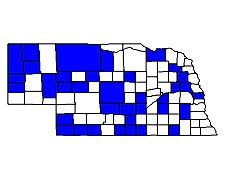Oblique-Lined Tiger Beetle |
|
|
|
| |
|
|
 |
 |
| Cicindela tranquebarica tranquebarica Herbst |
| Adult Length: 13 to 17 mm |
| Appearance: Adults are blackish brown to bronze-brown with a modest amount of maculation. Normally the apical and humeral lunules as well as the middle band are complete. The posthumeral mark is elongated and runs at an angle toward the posterior, and the apical mark becomes broader near the suture. The middle band is most often somewhat upturned at the “knee” section. The extent of the markings is somewhat variable, and those from the Pine Ridge tend to be especially heavily marked, and those from Wildcat Hills tend more toward brown-bronze to somewhat coppery in color with somewhat less maculation. |
| Similar Species: This species could be confused with C. formosa, C. duodecimguttata, or C. lengi. It differs from C. duodecimguttata in the elongated posthumeral mark. It differs from C. formosa in that C. formosaalways has a complete marginal band while C. tranquebarica does not, and that C. formosais strongly red in color. It differs from C. lengi mostly in color, as C. lengi is much more red in color, and C. tranquebarica specimens from Nebraska almost never have a marginal band fusing the humeral lunule to the middle band, while in C. lengi this is normal. Cicindela tranquebarica might also be confused with black specimens of C. fulgida, but C. fulgida is much smaller. |
| Biology: This species occurs mostly in areas where the water table is fairly near the soil surface. Though it can tolerate clayey soils, sandy soils are preferred. Habitats in Nebraska include sandy and loamy road banks, upper beaches, open areas in wet meadows, roadsides near streams, and a variety of other relatively moist areas. Though it occurs on moist soils, it is only rarely encountered along the edge of water bodies. |
| Adult Life History: Adults emerge from the pupa from mid-August to early September and are active for a few weeks before overwintering. A few fall adults may remain active well into October. Activity resumes in March and April, and peak numbers occur in April and early May. Adults are normally scarce by June. It is a spring-fall species. |
| Larval Life History: Eggs are laid mostly in March and April. Most larvae reach the third instar by fall before overwintering, and pupation occurs in July and August of the following summer. |
| Biogeography: This species is known from numerous locations across the state and likely occurs in most counties. In North America it occurs from northern British Columbia and Alberta to Newfoundland and south to South Carolina, Texas, and southern California. Eight subspecies are currently recognized. Populations in the Pine Ridge appear to share some characteristics with both ssp. kirbyi and ssp. diffracta, while those in the Wildcat Hills show some of the coppery tones typical of ssp. diffracta. |
|






